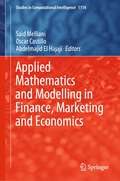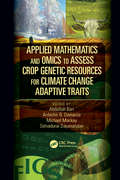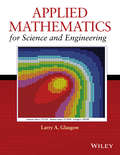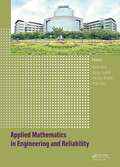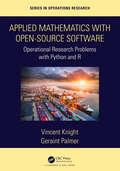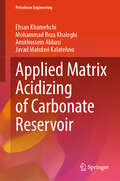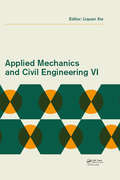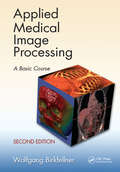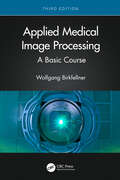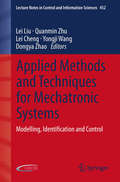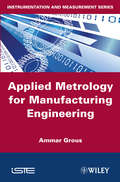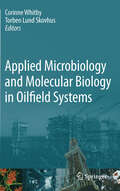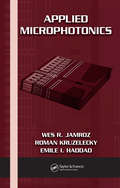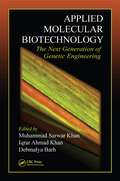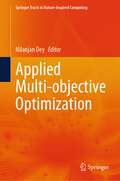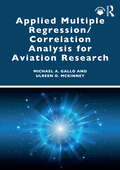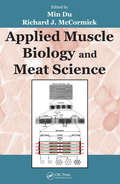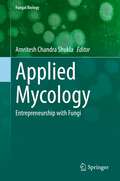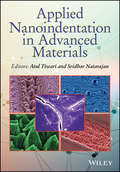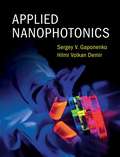- Table View
- List View
Applied Mathematics and Modelling in Finance, Marketing and Economics (Studies in Computational Intelligence #1114)
by Oscar Castillo Said Melliani Abdelmajid El HajajiThis book offers a comprehensive overview of the latest advancements in the field of applied mathematics as it relates to finance, marketing, and economics. It covers a range of topics including the effective utilization of applied mathematics and mathematical modeling in finance, economics, and marketing. Additionally, it explores the intersection between applied mathematics and practical applications in various scientific fields. The book targets a multidisciplinary audience, fostering the exchange of diverse ideas and showcasing the broad appeal of different subjects. It delves into recent developments in areas such as mathematical modeling in finance, mathematical modeling in marketing, the modeling of financial and economic fundamentals (e.g., interest rates, asset prices), market behavior modeling, modeling market imperfections, pricing financial derivative securities, hedging strategies, numerical methods, and financial engineering. The book features selected contributions presented at the first edition of the International Conference in Applied Mathematics to Finance, Marketing and Economics, which took place at the National School of Commerce and Management in El Jadida, Morocco, from November 26 to 27, 2020.
Applied Mathematics and Omics to Assess Crop Genetic Resources for Climate Change Adaptive Traits
by Abdallah Bari, Ardeshir B. Damania, Michael Mackay and Selvadurai DayanandanApplied Mathematics and Omics to Assess Crop Genetic Resources for Climate Change Adaptive Traits focuses on practical means and approaches to further the use of genetic resources for mitigating the effects of climate change and improving crop production. Genetic diversity in crop plants is being further explored to increase yield, disease resistance, and nutritional value by employing recent advances in mathematics and omics technologies to promote the adaptation of crops to changing climatic conditions. This book presents a broad view of biodiversity and genetic resources in agriculture and provides answers to some current problems. It also highlights ways to provide much-needed information to practitioners and innovators engaged in addressing the effects of global climate change on agriculture. The book is divided into sections that cover: The implications of climate change for drylands and farming communities The potential of genetic resources and biodiversity to adapt to and mitigate climate change effects Applications of mathematics and omics technologies Genomics and gene identification We are in the midst of significant changes in global climates, and its effects are already being felt throughout the world. The increasing frequency of droughts and heat waves has had negative impacts on agricultural production, especially in the drylands of the world. This book shares the collective knowledge of leading scientists and practitioners, giving readers a broader appreciation and heightened awareness of the stakes involved in improving and sustaining agricultural production systems in the face of climate change.
Applied Mathematics for Science and Engineering
by Larry A. GlasgowPrepare students for success in using applied mathematics for engineering practice and post-graduate studies * moves from one mathematical method to the next sustaining reader interest and easing the application of the techniques * Uses different examples from chemical, civil, mechanical and various other engineering fields * Based on a decade's worth of the authors lecture notes detailing the topic of applied mathematics for scientists and engineers * Concisely writing with numerous examples provided including historical perspectives as well as a solutions manual for academic adopters
Applied Mathematics in Engineering and Reliability: Proceedings of the 1st International Conference on Applied Mathematics in Engineering and Reliability (Ho Chi Minh City, Vietnam, 4-6 May 2016)
by Phan Dao Chu Duc Khanh Radim Briš & Václav SnášelApplied Mathematics in Engineering and Reliability contains papers presented at the International Conference on Applied Mathematics in Engineering and Reliability (ICAMER 2016, Ho Chi Minh City, Viet Nam, 4-6 May 2016). The book covers a wide range of topics within mathematics applied in reliability, risk and engineering, including:- Risk and Relia
Applied Mathematics in Hydrogeology
by Tien-Chang LeeAs introduced in Dr. Lee's 10-week class, Applied Mathematics in Hydrogeology is written for professionals and graduate students who have a keen interest in the application of mathematics in hydrogeology.Its first seven chapters cover analytical solutions for problems commonly encountered in the study of quantitative hydrogeology, while the final three chapters focus on solving linear simultaneous equations, finite element analysis, and inversion for parameter determination.Dr. Lee provides various equation-solving methods that are of interest to hydrogeologists, geophysicists, soil scientists, and civil engineers, as well as applied physicists and mathematicians. In the classroom, this same information will help students realize how familiar equations in hydrogeology are derived-an important step toward development of a student's own mathematical models.Unlike other applied mathematics books that are structured according to systematic methodology, Applied Mathematics in Hydrogeology emphasizes equation-solving methods according to topics. Hydrogeological problems and governing differential equations are introduced, including hydraulic responses to pumping in confined and unconfined aquifers, as well as transport of heat and solute in flowing groundwater.
Applied Mathematics with Open-Source Software: Operational Research Problems with Python and R (Chapman & Hall/CRC Series in Operations Research)
by Vincent Knight Geraint PalmerApplied Mathematics with Open-source Software: Operational Research Problems with Python and R is aimed at a broad segment of readers who wish to learn how to use open-source software to solve problems in applied mathematics. The book has an innovative structure with 4 sections of two chapters covering a large range of applied mathematical techniques: probabilistic modelling, dynamical systems, emergent behaviour and optimisation. The pairs of chapters in each section demonstrate different families of solution approaches. Each chapter starts with a problem, gives an overview of the relevant theory, shows a solution approach in R and in Python, and finally gives wider context by including a number of published references. This structure will allow for maximum accessibility, with minimal prerequisites in mathematics or programming as well as giving the right opportunities for a reader wanting to delve deeper into a particular topic. Features An excellent resource for scholars of applied mathematics and operational research, and indeed any academics who want to learn how to use open-source software. Offers more general and accessible treatment of the subject than other texts, both in terms of programming language but also in terms of the subjects considered. The R and Python sections purposefully mirror each other so that a reader can read only the section that interests them. An accompanying open-source repository with source files and further examples is posted online at https://bit.ly/3kpoKSd.
Applied Matrix Acidizing of Carbonate Reservoir (Petroleum Engineering)
by Ehsan Khamehchi Mohammad Reza Khaleghi Amirhossein Abbasi Javad Mahdavi KalatehnoThis book enhances readers’ understanding of matrix acidizing and its pivotal role in the oil and gas industry. It is a comprehensive guide to maximizing reservoir performance. The book explores carbonate reservoirs, where acid meets rock, and indicates pathways to increased well productivity. Based on extensive research, the book has insights for students, professionals, and researchers and all those interesting in realizing the full potential of oil and gas reservoirs.
Applied Mechanical Design: Solved Case Studies And Projects
by Ammar GrousThis book is the result of lessons, tutorials and other laboratories dealing with applied mechanical design in the universities and colleges. In the classical literature of the mechanical design, there are quite a few books that deal directly and theory and case studies, with their solutions. All schools, engineering colleges (technical) industrial and research laboratories and design offices serve design works. However, the books on the market remain tight in the sense that they are often works of mechanical constructions. This is certainly beneficial to the ordinary user, but the organizational part of the functional specification items is also indispensable.
Applied Mechanics and Civil Engineering VI
by Liquan XieApplied Mechanics and Civil Engineering VI includes the contributions to the 6th International Conference on Applied Mechanics and Civil Engineering (AMCE 2016, Hong kong, China, 30-31 December 2016), and showcases the challenging developments in the areas of applied mechanics, civil engineering and associated engineering practice. The book covers a wide variety of topics:- Applied mechanics and its applications in civil engineering;- Bridge engineering;- Underground engineering;- Structural safety and reliability;- Reinforced concrete (RC) structures;- Rock mechanics and rock engineering;- Geotechnical in-situ testing & monitoring;- New construction materials and applications;- Computational mechanics;- Natural hazards and risk, and- Water and hydraulic engineering. Applied Mechanics and Civil Engineering VI will appeal to professionals and academics involved in the above mentioned areas, and it is expected that the book will stimulate new ideas, methods and applications in ongoing civil engineering advances.
Applied Medical Image Processing: A Basic Course
by Wolfgang BirkfellnerA widely used, classroom-tested text, Applied Medical Image Processing: A Basic Course delivers an ideal introduction to image processing in medicine, emphasizing the clinical relevance and special requirements of the field. Avoiding excessive mathematical formalisms, the book presents key principles by implementing algorithms from scratch and usin
Applied Medical Image Processing: A Basic Course
by Wolfgang BirkfellnerA widely used, classroom-tested text, Applied Medical Image Processing: A Basic Course delivers an ideal introduction to image processing in medicine, emphasizing the clinical relevance and special requirements of the field. Avoiding excessive mathematical formalisms, the book presents key principles by implementing algorithms from scratch and using simple MATLAB®/Octave scripts with image data and illustrations on an accompanying companion website. Organized as a complete textbook, it provides an overview of the physics of medical image processing and discusses imaging physics, clinical applications of image processing, image formats and data storage, intensity transforms, filtering of images and applications of the Fourier transform, three-dimensional spatial transforms, volume rendering, image registration, tomographic reconstruction and basic machine learning.This Third Edition of the bestseller: Contains a brand-new chapter on the basics of machine learning Devotes more attention to the subject of color space Includes additional examples from radiology, internal medicine, surgery, and radiation therapy Incorporates freely available programs in the public domain (e.g., GIMP, 3DSlicer, and ImageJ) when applicable Beneficial to students of medical physics, biomedical engineering, computer science, applied mathematics, and related fields, as well as medical physicists, radiographers, radiologists, and other professionals, Applied Medical Image Processing: A Basic Course, Third Edition is fully updated and expanded to ensure a perfect blend of theory and practice.Wolfgang Birkfellner studied theoretical physics at, and holds a Ph.D in medical physics from, the University of Vienna, Austria. Currently, he is heading the Digital Image Processing Laboratory at the Center for Biomedical Engineering and Physics at the Medical University of Vienna. He is also a reviewer and editorial board member for major journals in the field, program committee member for international conferences, and principal investigator for several third-party funded research projects. Previously, he served as senior researcher at the University Hospital Basel/Switzerland and associate professor of medical physics at the Center for Biomedical Engineering and Physics of Vienna Medical School.
Applied Metal Forming
by Henry S. ValbergApplied Metal Forming: Using FEM Analysis describes metal forming theory and how experimental techniques can be used to study any metal forming operation with great accuracy. For each primary class of processes, such as forging, rolling, extrusion, wiredrawing, and sheet-metal forming, it explains how FEA (Finite Elements Analysis) can be applied with great precision to characterize the forming condition and in this way optimize the processes. FEA has made it possible to build very realistic FEM-models of any metal forming process, including complex three-dimensional forming operations, in which complex products are shaped by complex dies. Thus, using FEA it is now possible to visualize any metal forming process and to study strain, stresses, and other forming conditions inside the parts being manufactured as they develop throughout the process.
Applied Methods and Techniques for Mechatronic Systems: Modelling, Identification and Control (Lecture Notes in Control and Information Sciences #452)
by Lei Liu Quanmin Zhu Lei Cheng Yongji Wang Dongya ZhaoApplied Methods and Techniques for Mechatronic Systems brings together the relevant studies in mechatronic systems with the latest research from interdisciplinary theoretical studies, computational algorithm development and exemplary applications. Readers can easily tailor the techniques in this book to accommodate their ad hoc applications. The clear structure of each paper, background - motivation - quantitative development (equations) - case studies/illustration/tutorial (curve, table, etc. ) is also helpful. It is mainly aimed at graduate students, professors and academic researchers in related fields, but it will also be helpful to engineers and scientists from industry. Lei Liu is a lecturer at Huazhong University of Science and Technology (HUST), China; Quanmin Zhu is a professor at University of the West of England, UK; Lei Cheng is an associate professor at Wuhan University of Science and Technology, China; Yongji Wang is a professor at HUST; Dongya Zhao is an associate professor at China University of Petroleum.
Applied Metrology for Manufacturing Engineering (Wiley-iste Ser.)
by Ammar GrousApplied Metrology for Manufacturing Engineering, stands out from traditional works due to its educational aspect. Illustrated by tutorials and laboratory models, it is accessible to users of non-specialists in the fields of design and manufacturing. Chapters can be viewed independently of each other. This book focuses on technical geometric and dimensional tolerances as well as mechanical testing and quality control. It also provides references and solved examples to help professionals and teachers to adapt their models to specific cases. It reflects recent developments in ISO and GPS standards and focuses on training that goes hand in hand with the progress of practical work and workshops dealing with measurement and dimensioning.
Applied Microbiology and Molecular Biology in Oilfield Systems: Proceedings from the International Symposium on Applied Microbiology and Molecular Biology in Oil Systems (ISMOS-2), 2009
by Torben Lund Skovhus Corinne WhitbyApplied Microbiology and Molecular Biology in Oil Field Systems addresses the major problems microbes cause in oil fields, (e.g. biocorrosion and souring) and how beneficial microbial activities may be exploited (e.g. MEOR and biofuels). The book describes theoretical and practical approaches to specific Molecular Microbiological Methods (MMM), and is written by leading authorities in the field from both academia and industry. The book describes how MMM can be applied to faciliate better management of oil reservoirs and downstream processes. The book is innovative in that it utilises real industrial case studies which gives useful technical and scientific information to researchers, engineers and microbiologists working with oil, gas and petroleum systems.
Applied Microphotonics (Optical Science and Engineering)
by Wes R. Jamroz Roman Kruzelecky Emile I. HaddadAs the limits of electrical performance come within sight, photons are poised to take over for the electron. But the search continues for the materials, topologies, and fabrication technologies capable of producing photonic devices at a reasonable speed and cost. Taking a fundamentallook at the development of photonic technology from the macro- to the microscale, Applied Microphotonics introduces the major principles and technologies underlying the field.Following an overview of historical and commercial driving forces, the authors briefly review the underlying physics, emphasizing the practical and design implications for photonic systems. This general discussion lays the foundation for the remainder of the book, where the authors first introduce the photonic node and then discuss each subsystem in detail, including transmitters, couplers and switches, multiplexers and demultiplexers, receivers, amplifiers, and compensators. The following chapters explore new technologies such as photonic band gap structures, materials and fabrication processes, integration methodologies, and advanced devices such as photonic computers. The book concludes with a brief introduction to quantum photonics and a forward look at potential directions of photonics. Applied Microphotonics encapsulates the recent push toward all-optical networks and devices with an applications-oriented perspective. It is ideal for newcomers to the field as well as anyone curious to know how photonic technology can benefit their own field.
Applied Minds: How Engineers Think
by Guru MadhavanA journey inside the minds that build our world. Dubai's Burj Khalifa--the world's tallest building--looks nothing like Microsoft's Office Suite, and digital surround sound doesn't work like a citywide telecommunication grid. Yet these engineering feats have much in common. Applied Minds explores the unique visions and mental tools of engineers to reveal the enormous--and often understated--influence they wield in transforming problems into opportunities. The resulting account pairs the innovators of modern history--Thomas Edison, the Wright brothers, Steve Jobs--with everything from ATMs and the ZIP code system to the disposable diaper. An engineer himself, Guru Madhavan introduces a flexible intellectual tool kit called modular systems thinking as he explains the discipline's penchant for seeing structure where there is none. The creations that result from this process express the engineer's answers to the fundamental questions of design: usefulness, functionality, reliability, and user friendliness. Through narratives and case studies spanning the brilliant history of engineering, Madhavan shows how the concepts of prototyping, efficiency, reliability, standards, optimization, and feedback are put to use in fields as diverse as transportation, retail, health care, and entertainment. Equal parts personal, practical, and profound, Applied Minds charts a path to a future where we apply strategies borrowed from engineering to create useful and inspired solutions to our most pressing challenges.
Applied Mineral Inventory Estimation
by Alastair J. Sinclair Garston H. BlackwellApplied Mineral Inventory Estimation presents a comprehensive applied approach to the estimation of mineral resources/reserves with particular emphasis on the geological basis of such estimations, the need for and maintenance of a high quality assay data base, the practical use of a comprehensive exploratory data evaluation, and the importance of a comprehensive geostatistical approach to the estimation methodology. Practical problems and real data are used throughout as illustrations: each chapter ends with a summary of practical concerns, a number of practical exercises and a short list of references for supplementary study. This textbook is suitable for any university or mining school that offers senior undergraduate and graduate student courses on mineral resource/reserve estimation. It will also be valuable for professional mining engineers, geological engineers and geologists working with mineral exploration and mining companies.
Applied Molecular Biotechnology: The Next Generation of Genetic Engineering
by Iqrar Ahmad Khan Debmalya Barh Muhammad Sarwar KhanApplied Molecular Biotechnology: The Next Generation of Genetic Engineering explains state-of-the-art advances in the rapidly developing area of molecular biotechnology, the technology of the new millennium. Comprised of chapters authored by leading experts in their respective fields, this authoritative reference text:Highlights the latest omics-ba
Applied Multi-objective Optimization (Springer Tracts in Nature-Inspired Computing)
by Nilanjan DeyThe book explains basic ideas behind several kinds of applied multi-objective optimization and shows how it will be applied in practical contexts in the domain of healthcare, engineering design, and manufacturing. The book discusses how meta-heuristic algorithms are successful in resolving challenging, multi-objective optimization issues in various disciplines, including engineering, economics, medical and environmental management. The topic is useful for graduates, researchers and lecturers in optimization, engineering, management science and computer science.
Applied Multiple Regression/Correlation Analysis for Aviation Research
by Michael A. Gallo Ulreen O. McKinneyApplied Multiple Regression/Correlation Analysis for Aviation Research describes and illustrates multiple regression/correlation (MRC) analysis in an aviation context, including flight instruction, airport design, airline routes, and aviation human factors research. Structured in four parts, the book first reviews the major concepts of bivariate correlation and regression and then extends the bivariate case to two, four, and k predictors coupled with discussions on statistical inference, underlying assumptions, and regression diagnostics relative to MRC analysis. The book then builds on this foundation by presenting MRC variable selection strategies (simultaneous, hierarchical, and statistical regression), analyzing sets of predictors, and introducing coding strategies for nominal predictors. The book concludes by presenting how MRC can be used to conduct an analysis of covariance (ANCOVA), interactions, mediation analysis, and binary logistic regression.Throughout the presentation, the book provides a balance between procedural knowledge as well as conceptual understanding. Detailed guided examples are presented at the end of each chapter that apply the topics and concepts of the chapter from the perspective of conducting a research study. The analytic strategies demonstrated via these guided examples are clearly explained, enabling readers to understand, conduct, and report results correctly. Pedagogical features associated with each chapter include a set of student learning outcomes and an end-of-chapter package that consists of a summary of the chapter’s main topics/concepts, a list of key terms, and review exercises, including multiple-choice items and a research scenario with data for students to analyze.Tailored to the needs of aviation students, Applied Multiple Regression/Correlation Analysis for Aviation Research is the ideal textbook for research-oriented graduate aviation programs such as a thesis-based master’s degree or doctoral program that require knowledge of advanced statistical strategies for analyzing research data.
Applied Muscle Biology and Meat Science
by Richard J. McCormick Min DuKnowledge of muscle biology is continuing to expand in the animal and food sciences industry, especially the understanding of the mechanisms that control skeletal muscle development, growth, and their impacts on meat production and quality. Applied Muscle Biology and Meat Science provides agriculturalists with state-of-the-art information and a platform to further explore this specialized topic. It also gives novices a comprehensive knowledge base in applied muscle biology and meat science. Many existing problems in meat science and production are due to a lack of understanding of the underlying biological mechanisms of the livestock. Careful to avoid gory processing details, the text focuses on biological changes and the appropriate manage
Applied Mycology: Entrepreneurship with Fungi (Fungal Biology)
by Amritesh Chandra ShuklaFungi are an important link in the food webs of all ecosystems. They have immense potential and comprise a myriad of useful bioactive compounds. Fungi feature in a wide range of diverse processes and applications in modern agriculture, the food science industry, and the pharmaceutical industry. In the food and drink arena, the role of fungi is historically important in the form of mushrooms and in fermented foods as yeasts for baking and brewing. These roles are supplemented by the use of fungal food processing enzymes and additives, and more recently in the development of protein-based foodstuffs from fungi. Additionally, they are used in the formulation of biofertilizers and biopesticides used as biostimulants and bioprotectants of crops. The practical use of newer techniques such as genetic recombination and robotics have revolutionized the modem agricultural biotechnology industry, and have created an enormous range of possible further applications of fungal products.Myco-materials created from mycelia (the root-like parts of fungi) are gaining attention as a sustainable alternative for a wide range of materials. They are being used as insulation, sustainable packaging, foam inserts, and even "eco-leather.” In fact, mycelium bricks are pound-for-pound stronger than concrete. In addition, medicinal uses of fungal species have been historically recorded as important agents in the pharmaceutical sciences. The potential for myco-materials seems limitless. The field of mycology and its application has become an increasingly important component in the education of industrial biotechnology. This book on applied mycology provides information helpful for developing entrepreneurial opportunities with fungi. This volume explains both the basic science and the applications of mycology and bio-resource technology with special emphasis on entrepreneurial applications. It offers a complete, one-stop resource for those interested in microbiology, food and agricultural science, medical mycology, and for those in industrial biotechnology.
Applied Nanoindentation in Advanced Materials
by Atul Tiwari Sridhar NatarajanResearch in the area of nanoindentation has gained significant momentum in recent years, but there are very few books currently available which can educate researchers on the application aspects of this technique in various areas of materials science. Applied Nanoindentation in Advanced Materials addresses this need and is a comprehensive, self-contained reference covering applied aspects of nanoindentation in advanced materials. With contributions from leading researchers in the field, this book is divided into three parts. Part one covers innovations and analysis, and parts two and three examine the application and evaluation of soft and ceramic-like materials respectively. Key features: A one stop solution for scholars and researchers to learn applied aspects of nanoindentation Contains contributions from leading researchers in the field Includes the analysis of key properties that can be studied using the nanoindentation technique Covers recent innovations Includes worked examples Applied Nanoindentation in Advanced Materials is an ideal reference for researchers and practitioners working in the areas of nanotechnology and nanomechanics, and is also a useful source of information for graduate students in mechanical and materials engineering, and chemistry. This book also contains a wealth of information for scientists and engineers interested in mathematical modelling and simulations related to nanoindentation testing and analysis.
Applied Nanophotonics
by Sergey V. Gaponenko Hilmi Volkan DemirWith full color throughout, this unique text provides an accessible yet rigorous introduction to the basic principles, technology, and applications of nanophotonics. It explains key physical concepts such as quantum confinement in semiconductors, light confinement in metal and dielectric nanostructures, and wave coupling in nanostructures, and describes how they can be applied in lighting sources, lasers, photonic circuitry, and photovoltaic systems. Readers will gain an intuitive insight into the commercial implementation of nanophotonic components, in both current and potential future devices, as well as challenges facing the field. The fundamentals of semiconductor optics, optical material properties, and light propagation are included, and new and emerging fields such as colloidal photonics, Si-based photonics, nanoplasmonics, and bioinspired photonics are all discussed. This is the 'go-to' guide for graduate students and researchers in electrical engineering who are interested in nanophotonics, and students taking nanophotonics courses.
